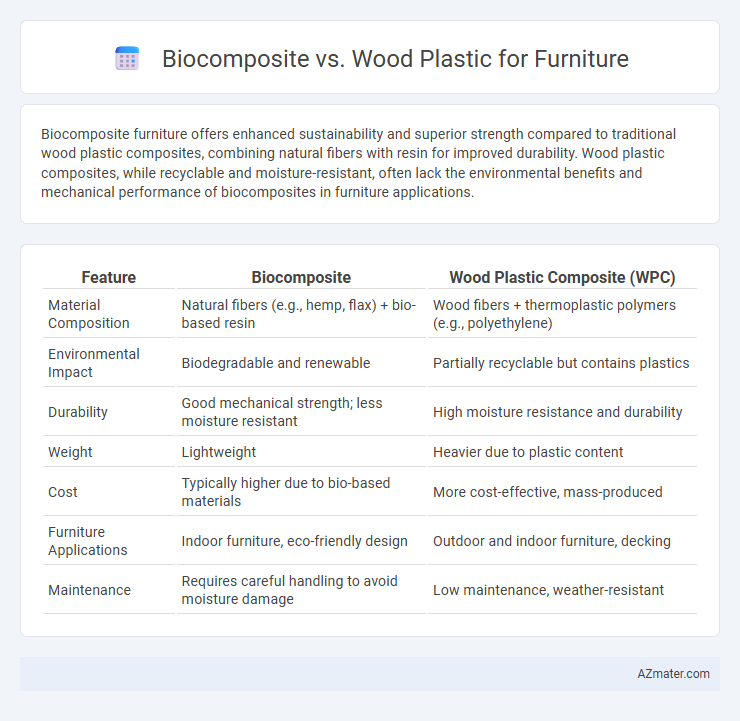Biocomposite furniture offers enhanced sustainability and superior strength compared to traditional wood plastic composites, combining natural fibers with resin for improved durability. Wood plastic composites, while recyclable and moisture-resistant, often lack the environmental benefits and mechanical performance of biocomposites in furniture applications.
Table of Comparison
| Feature | Biocomposite | Wood Plastic Composite (WPC) |
|---|---|---|
| Material Composition | Natural fibers (e.g., hemp, flax) + bio-based resin | Wood fibers + thermoplastic polymers (e.g., polyethylene) |
| Environmental Impact | Biodegradable and renewable | Partially recyclable but contains plastics |
| Durability | Good mechanical strength; less moisture resistant | High moisture resistance and durability |
| Weight | Lightweight | Heavier due to plastic content |
| Cost | Typically higher due to bio-based materials | More cost-effective, mass-produced |
| Furniture Applications | Indoor furniture, eco-friendly design | Outdoor and indoor furniture, decking |
| Maintenance | Requires careful handling to avoid moisture damage | Low maintenance, weather-resistant |
Introduction to Biocomposite and Wood Plastic
Biocomposites combine natural fibers such as hemp, flax, or jute with a polymer matrix, offering enhanced strength and eco-friendliness in furniture manufacturing. Wood plastic composites (WPC) blend wood fibers with thermoplastics like polyethylene or polypropylene, providing durability, resistance to moisture, and low maintenance. Both materials serve as sustainable alternatives to traditional wood, with biocomposites emphasizing biodegradability and WPCs highlighting weather resistance for long-lasting furniture applications.
Material Composition and Characteristics
Biocomposites combine natural fibers such as hemp, flax, or jute with a polymer matrix, offering enhanced biodegradability and superior strength-to-weight ratios compared to traditional wood plastic composites (WPCs). Wood plastic composites primarily consist of wood flour or fibers blended with thermoplastics like polyethylene or polypropylene, providing increased moisture resistance and durability but lower environmental sustainability. The distinct material compositions result in biocomposites exhibiting improved eco-friendliness and mechanical performance, while WPCs are favored for their maintenance ease and resistance to rot in furniture applications.
Environmental Impact and Sustainability
Biocomposites, made from natural fibers and biodegradable resins, offer superior environmental benefits compared to wood plastic composites (WPCs) by reducing reliance on fossil fuels and minimizing plastic pollution. Wood plastic composites combine wood fibers with recycled plastics, which helps divert plastic waste from landfills but still involves non-biodegradable components that can persist in the environment. Choosing biocomposites for furniture promotes sustainability through enhanced biodegradability, lower carbon footprint, and renewable raw materials, making them a more eco-friendly option than traditional WPCs.
Durability and Longevity in Furniture
Biocomposite materials combine natural fibers with polymers, offering enhanced durability and resistance to moisture, insects, and UV exposure compared to traditional wood plastic composites (WPC). Wood plastic composites often degrade faster due to lower resistance to environmental stressors, leading to reduced longevity in outdoor or high-use furniture applications. Selecting biocomposites ensures longer-lasting furniture with superior structural integrity and maintenance advantages over wood plastic alternatives.
Aesthetic Appeal and Customization
Biocomposite materials offer a wide range of customizable textures, colors, and finishes, enabling designers to create unique and visually striking furniture pieces that mimic natural wood grain while providing enhanced durability. Wood plastic composites tend to have a more uniform appearance with limited customization options, often resulting in less intricate aesthetic details compared to biocomposites. The superior versatility in biocomposites supports innovative design choices that cater to both modern and traditional styles, appealing to consumers seeking personalized and attractive furniture solutions.
Mechanical Strength and Performance
Biocomposites offer superior mechanical strength compared to traditional wood plastic composites, featuring higher tensile strength and improved impact resistance due to natural fiber reinforcement. Wood plastic composites tend to have lower durability under heavy loads but provide better moisture resistance and dimensional stability. For furniture applications requiring robust performance and longevity, biocomposites are preferable where high load-bearing capacity is essential.
Cost Comparison and Market Availability
Biocomposite furniture often incurs higher initial costs due to specialized raw materials like natural fibers and bio-based resins, whereas wood plastic composites (WPC) tend to be more affordable by utilizing recycled plastics combined with wood flour. Market availability favors WPC products as they are widely produced and distributed globally, benefiting from established manufacturing infrastructure and recycling networks. The cost advantage of WPC combined with broader market presence makes it a more accessible choice for cost-sensitive furniture applications.
Maintenance and Care Requirements
Biocomposite furniture demands lower maintenance due to its resistance to moisture, rot, and insect damage compared to traditional wood plastic composites, reducing the need for frequent sealing or painting. Wood plastic composites often require regular cleaning and protective treatments to maintain appearance and prevent surface deterioration caused by UV exposure and temperature fluctuations. Choosing biocomposites enhances durability and simplifies care routines, making them ideal for long-term furniture investment with minimal upkeep.
Applications in Modern Furniture Design
Biocomposites combine natural fibers with biodegradable polymers, offering sustainable and lightweight solutions ideal for ergonomic furniture and decorative panels in modern design. Wood plastic composites (WPC) incorporate wood fibers and thermoplastics, providing durability and resistance to moisture, making them suitable for outdoor furniture and structural components. Both materials enable innovative aesthetics and enhanced performance, meeting contemporary demands for eco-friendly and versatile furniture options.
Future Trends and Innovations
Biocomposite materials in furniture continue to advance with innovations in natural fiber reinforcements and biodegradable resins, enhancing sustainability and mechanical properties compared to traditional wood plastic composites (WPC). Emerging trends emphasize lightweight designs, increased durability, and circular economy principles, driving adoption in eco-conscious markets. Research on nanocellulose additives and 3D printing integration promises to revolutionize product customization and performance in both biocomposites and wood plastic furniture sectors.

Infographic: Biocomposite vs Wood Plastic for Furniture
 azmater.com
azmater.com